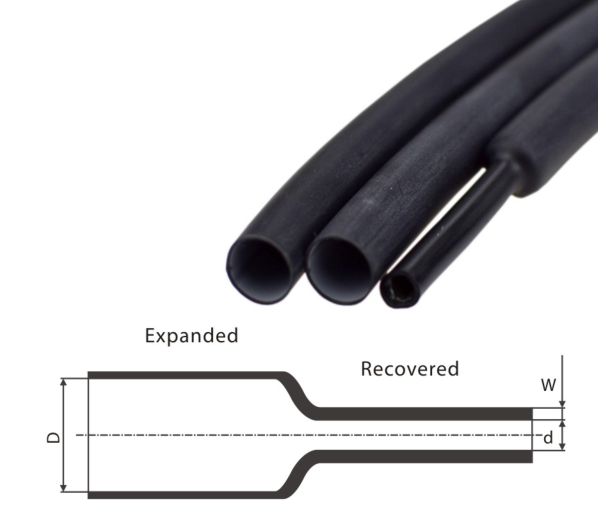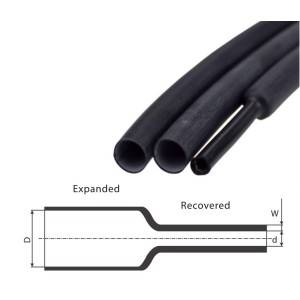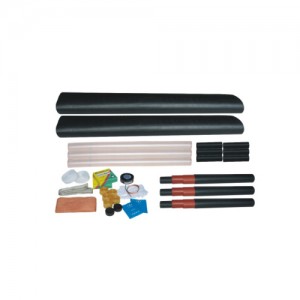Heat Shrink Insulating Tubing
Application
1.Used for medium voltage up to 36kV
2.Protection against moisture and pressure
3.Suitable for cable termination and intermediate connecting insulation protection
Feature
1.Hot melting adhesive provides better waterproof
2.Coating type:film coating
3.Excellent corrosion resistance
4.UV resistance and weathering resistance
5.Halogen-free
6.Superior electrical and mechanical properties
7.Shrinkage ratio 3:1
8.Medium wall
Feature
1.Preferable electrical appliance function
2.Reliable insulation
3.Superior hermetic sealing
4.Excellent heat /cold proof, waterproof, Anti-aging ,
5.Widely used at the field of electric power, electronic, petroleum, chemical engineering, construction and communication
The production of heat shrinkable tubing must first select the appropriate masterbatch, and then select the auxiliary materials to produce specific
The thermal housing casing.
1. The production process of heat shrinkable tube is firstly the production of polyene leech masterbatch: combining various polyene leech base materials with various functional auxiliary materials
The materials are weighed according to the formula ratio and then mixed: the mixed materials are put into a twin-screw extruder and pelletized to produce a polyene leech functional masterbatch.
2. Product molding process: according to the shape of the product, two methods of single screw extrusion and injection molding can be used.
For processing and production:
1. Single-screw extrusion type: mainly used for extrusion molding of heat sink pipes, such as single-wall heat-shrinkable tubes, double-wall heat-shrinkable tubes with glue, and medium thickness
Wall heat sink pipes, high pressure busbar heat sink pipes, high temperature heat shrinkable pipes and other products are all processed and formed by single screw extrusion.
The heat shrinkable tube production line should have the following equipment: extruder (heat sink tube forming), production mold, cooling water tank, tension device, and
Disk device, etc.
2. Injection molding: mainly used for the production of heat-shrinkable special-shaped parts, such as heat sink caps, heat-shrinkable umbrella skirts, heat-shrinkable finger cots and other products
They all use injection molding, and production equipment should include injection molding machines and injection molds.
3. The next important step is radiation cross-linking. The products formed by extrusion or injection molding are still linear molecular structures.
Structure, the product does not yet have the “memory function”, and the performance of temperature resistance, aging resistance, and wear resistance is not enough.
Change the molecular structure of the product. The method we usually use is radiation crosslinking modification: electron accelerator radiation crosslinking, cobalt source radiation
Cross-linking, peroxide chemical cross-linking, at this time the molecule changes from a linear molecular structure to a network structure. Extruded products are passing
After cross-linking, it has a “memory effect”, which greatly enhances the temperature resistance, mechanical properties, and chemical properties of the heat shrinkable tube. The specific table
Now the heat sink tube has changed from the state of tolerance to incompatible, aging resistance, abrasion resistance, and chemical corrosion resistance.
4. Expansion molding: The product modified by radiation crosslinking already has a “shape memory effect”, and it has a high
Non-melting performance under temperature. After heating at high temperature, vacuum blowing and cooling, it becomes the finished heat shrinkable tube, and then according to the tube
The actual situation of the finished product packaging and closing can also be cut and printed according to customer needs. Neutral normal packaging is also available.

Performance
| Test | Test Method | Requirement |
| Operating temperature | UL 224 | -50 to+125 ℃ |
| Tensile strength | ASTM D 2671 | ≥14 Mpa |
| Elongation at break | ASTM D 2671 | >400% |
| Elongation at break after heat aging | ASTM D 2671 158℃/168hrs | ≥300% |
| Longitudinal shrinkage | UL 224 | 0±5% |
| Partial wall rate | ASTM D 2671 | <30% |
| Flame retardancy | VW-1 | Pass |
| Volume resistivity | IEC 93 | >1014Ω.m |
| Copper stability | UL224 | Pass |
|
Type |
Application Diameter Range(mm) |
Expanded(mm) |
Recovered(mm) |
|
| D(min) | d(max) | W(min) | ||
| RSG-15/5 | 4.5-8 | 15 | 5 | 1.5 |
| RSG-20/8 | 6.5-14 | 20 | 8 | 1.8 |
| RSG-28/10 | 12-18 | 28 | 10 | 1.8 |
| RSG-35/14 | 17-27 | 35 | 14 | 2 |
| WRSG10-28/10 | 6.5-14 | 28 | 10 | 2.2 |
| WRSG10-34/14 | 17-27 | 34 | 14 | 2.3 |
| WRSG10-40/18 | 17-30 | 40 | 18 | 2.5 |
| WRSG10-50/20 | 17-35 | 50 | 20 | 2.5 |
| WRSG35-50/20 | 17-35 | 50 | 20 | 3 |
| WRSG35-60/22 | 21-45 | 60 | 22 | 3 |
| WRSG35-70/25 | 24-52 | 70 | 25 | 3 |








